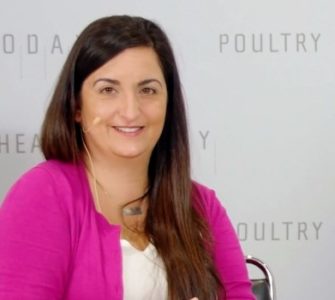Salmonella serotypes are changing — monitor which ones are in your flock
It’s imperative for poultry producers and companies to know what strains of Salmonella serotypes may be circulating in their flocks, said Chuck Hofacre, president of the Southern Poultry Research Group in Georgia.
“As Salmonellas on farms change, different Salmonellas will start to come into our processing plants,” he noted. “If they’re of human-health concern and…show up on the final product, then we’re going to have to change how we monitor and how we test our breeder and broiler flocks.”
Hofacre encourages companies to test their farms to understand which Salmonella serovars are in their broilers and/or breeders. Those serovars that survive all the way to whole-bird carcass rinse or parts rinse are the ones growers should focus on in their live production, he told Poultry Health Today. Monitoring live production provides useful information on what’s getting into the processing plant and whether or not breeder flocks are shedding Salmonella and trickling it down through the broilers in the plant.
“Our monitoring program really needs to focus on sussing out whether it’s a broiler issue or a breeder issue,” Hofacre said.
Common practice
Companies have begun to do more monitoring of their breeders, Hofacre explained, as a means of understanding which Salmonellas may be in their flocks. However, if they’re trying to better understand which Salmonella serovars could be at risk of coming into their processing plants, they’ll need to test more often.
“Breeders don’t just shed Salmonella continuously; they shed it intermittently,” he said. “If you look today, a flock may be shedding Salmonella Enteritidis, but tomorrow they may not. So routine monitoring of your breeders will help you to understand what your risk is from your breeders as it trickles down into the broilers.”
Sampling boot socks
Hofacre said sampling using boot socks can help give a prediction as to the likely load of Salmonella that may be coming into the plant.
“Boot socks have been the real go-to for the US and the international community for testing the environment,” he said. “We test the environment, the floor, and that tells us what those birds are shedding. Routine boot-sock monitoring at set times during a grow-out or during the breeder flock’s life will help us to understand if that breeder farm or breeder house has, say, Salmonella Enteritidis or Typhimurium or Heidelberg. And you want to do that repeatedly.
“For example, we may want to test all of our breeder flocks at 4 weeks of age, and perhaps again at 8 or 10 weeks, and once again before they come into egg production, so we understand as they go through their life cycle what Salmonellas they may have colonized in their intestines,” he continued.
Testing at the hatchery is another good way of looking at what Salmonellas may be circulating in the flocks that hatched that day, he added. “We can take fluff samples in the hatchery, or we can take swabs over the bottom of the baskets after the chicks have been in a basket for a while. We know the meconium (the first feces from a baby chick) is usually a very good indicator if they’ve been exposed to Salmonella. Hatchery samples are a good indicator of general Salmonella that are in the flocks for that day but may not be as good an indicator for a particular breeder flock.”
Cross-contamination happens
Testing on the farm is a good start, but it doesn’t provide all the answers because of cross-contamination at the plant.
“If it’s the first flock that’s processed that day, then yes, the testing on a farm tells us what the risk is,” Hofacre explained. “But if that first flock comes in and has Salmonella Infantis, then every flock after that has the potential of having Salmonella Infantis due to cross-contamination. Even though we have a lot of interventions in our processing plant to try to reduce Salmonella, we still have that risk of cross-contamination.”
Salmonella Infantis is becoming more common at the present time, though Hofacre said it’s not known why there are waves of different serotypes.
“Twenty years ago, Salmonella Typhimurium had just come into the industry throughout the world, and then it decreased, and then another Salmonella — Heidelberg — came in after it,” Hofacre said. “We don’t know why these different Salmonellas tend to replace each other as predominant within the broiler I and it’s really worldwide. We do know that one of the risks with Salmonella infantis is that it’s more likely to pick up antibody-resistance genes. It’s a real concern for the public-health community that we have a Salmonella causing foodborne illness that’s also carrying antibody resistance.”
Vaccination can help
Salmonella Infantis is a C1 serovar, so the live vaccines don’t stimulate as strong an immunity against C1 as they do against B’s or D’s. However, Hofacre said live vaccines offer some immunity and protection to Salmonella Infantis. Still, multiple interventions are important.
“Don’t just rely on your live vaccine,” he added. “You may want to use competitive exclusion, direct antimicrobial or organic acids in the drinking water at withdrawal time.”
What about Salmonella Kentucky?
Salmonella Kentucky counts against producers if it’s found by the Food Safety and Inspection Service (FSIS), even though it’s not considered particularly harmful to human health. However, Hofacre said there are some strains of Salmonella Kentucky that originated out of the Middle East and moved into Europe that have the ability to become more virulent and potentially create a human-health hazard.
“They have also picked up some antibiotic-resistance genes,” he said.
If a strain that is more virulent to humans and that is also antibiotic resistant were to come into the US and become a predominant Salmonella, it would be a problem.
“Everyone is worried about Kentucky because they’re failing their FSIS testing, but they also need to be concerned that if we get the bad [strain] from Europe, we could have a problem with Salmonella Kentucky, and that’s going to be a much more difficult one to deal with,” Hofacre said.
React quickly
It’s a case of keeping an eye on things and being able to react quickly, Hofacre noted.
“Most companies I’ve worked with over the past have recognized that they need to work hard against those Salmonellas that can cause human foodborne illness in their breeders and try to reduce it coming into their broilers,” he pointed out. “They know those are the ones that have the potential to result in a recall ⸺ not just failure in the processing plant.”
Posted on September 28, 2022

















